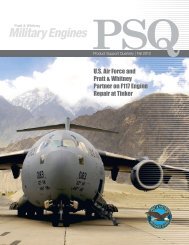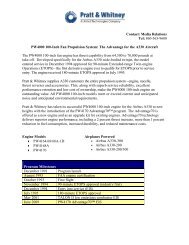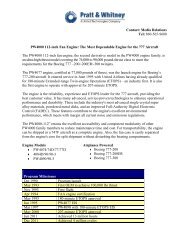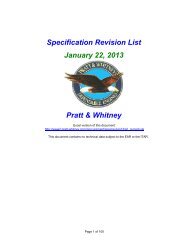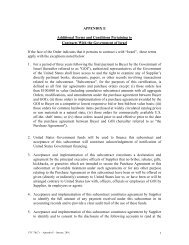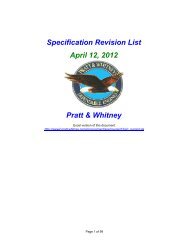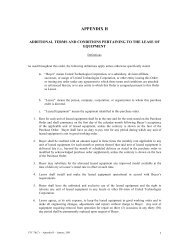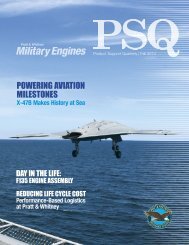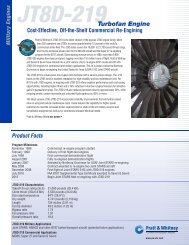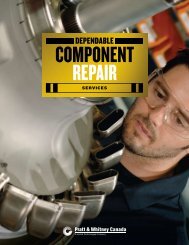Customer
Catalog - Pratt & Whitney
Catalog - Pratt & Whitney
Create successful ePaper yourself
Turn your PDF publications into a flip-book with our unique Google optimized e-Paper software.
ATA Specification 104/<br />
Definitions for Training Levels<br />
Level I: General Familiarization<br />
Personnel must be familiar with current equipment and<br />
have a general knowledge of turbine-powered transport<br />
aircraft. Level I provides a brief overview of the airframe,<br />
systems and power plant as outlined in the Systems<br />
Description Section of the Aircraft Maintenance Manual.<br />
Level II: Ramp and Transit<br />
Personnel must be familiar with turbine-powered transport<br />
aircraft digital electronic equipment and have experience in<br />
ramp, transit and turnaround activity. Level II provides a<br />
basic system overview; a description of controls, indicators<br />
and principal components including their location; and<br />
practical training on servicing and minor troubleshooting.<br />
European Aviation Safety<br />
Agency (EASA)<br />
Pratt & Whitney <strong>Customer</strong> Training is an approved European<br />
Aviation Safety Agency (EASA) Part 147 Maintenance Training<br />
Organization. Certification allows Pratt & Whitney <strong>Customer</strong><br />
Training to provide “type training” for European aircraft and<br />
power plant technicians as required by their respective EASA<br />
Part 66 curricula.<br />
Part 147 certification also ensures that Pratt & Whitney<br />
<strong>Customer</strong> Training’s facility, processes, records, personnel,<br />
equipment and examinations continuously meet the highest<br />
standards. Experienced and qualified instructors undergo<br />
training every year to stay current with the latest technical<br />
upgrades, training techniques and regulatory requirements. In<br />
addition, our EASA-qualified examiners provide hands-on<br />
assessments and exams following each class.<br />
Part 66 Appendix III type-training levels are based upon ATA 104 (Air Transport<br />
Association) corresponding-type training levels.<br />
Level III: Line and Base Maintenance Training<br />
Personnel attending Level III training should, in addition to<br />
requirements for Levels I and II, possess the knowledge<br />
and experience required to maintain turbine-powered<br />
transport aircraft. Level III provides a detailed description of<br />
the operation, component location, removal/installation and<br />
troubleshooting procedures to maintenance manual level.<br />
Level IV: Specialized Training<br />
Entry level is defined by subject matter. Personnel must<br />
have considerable experience in the field in which training<br />
will be received. Level IV provides a detailed description,<br />
component location, in-depth troubleshooting, adjustment,<br />
test procedures, rigging, in-depth use of wiring diagrams,<br />
schematics and engineering data.<br />
Level V: Component Overhaul Training<br />
Entry level is defined by subject matter. Personnel must<br />
meet prerequisites established by the vendor. Specialized<br />
overhaul training is conducted by airframe/engine<br />
manufacturers and/or their suppliers to a component<br />
maintenance manual level.<br />
EASA Certificate<br />
4



